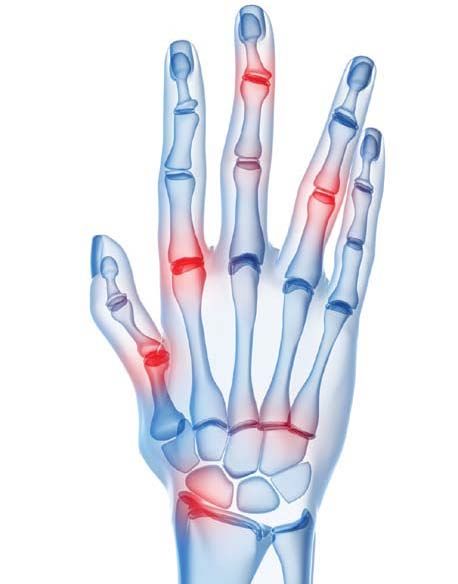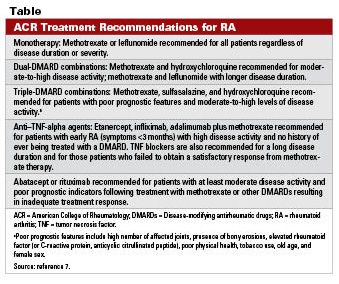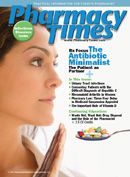Publication
Article
Pharmacy Times
Rheumatoid Arthritis and Women: A Debilitating Condition
Author(s):
Counseling rheumatoid arthritis (RA) patients is challenging, requiring gender-specific counseling issued for women RA patients.
Dr. Zanni is a psychologist and health systems consultant, Alexandria, Virginia.


Rheumatoid arthritis (RA), affecting 1.3 million Americans, is a chronic autoimmune systemic inflammatory disease with unknown etiology.1 RA primarily targets synovial linings of peripheral joints symmetrically, although other organs (heart, lungs, eyes, nervous system, and blood vessels) can be affected.2,3 Its insidious onset starts with morning joint stiffness, fatigue, malaise, and pain.3
RA progresses in 3 stages: synovial lining swelling (leading to warmth, stiffness, joint swelling); pannus (rapid cell division and growth) thickening the synovium; and inflamed cells releasing enzymes, causing misshapen, misaligned, painful joints.4 Destructive changes in the periarticular bone are called bony erosions. RA is also characterized by generalized osteoporosis and periarticular osteoporosis. Clinicians measure disease severity and treatment response using radiographic scoring systems.2
RA is progressive and incurable. Disease progression includes remissions and exacerbations with eventual disability: 70% have difficulty performing common tasks, 33% cannot work after 5 years, and 50% have substantial disability after 10 years.3 RA also increases morbidity, shortening life by 5 to 10 years.
A strong genetic component is confirmed with a genetic marker—disease concordance in monozygotic twins is between 15% and 20%.3 Environmental factors, including infection, may act as triggers for the genetically susceptible. Although several infectious agents have been implicated, no known pathogen has been identified.
Worldwide prevalence is 1%, with annual incidence estimated at 3 cases per 10,000.3 Incidence increases with age, peaking between 35 and 50 years. RA is 2 to 3 times more common in women, suggesting sex hormones, particularly estrogen, play a role.3,4 Evidence demonstrates that autoimmunity is genetically controlled by genes in sex chromosomes.5 Up to 75% of women with RA experience improvement during pregnancy and worsening 4 to 6 months after delivery. Additionally, RA incidence decreases in women taking oral contraceptives.3
Assessment
Joints commonly affected are the metacarpophalangeal, wrist, proximal interphalangeal, knee, metatarsophalangeal, shoulder, ankle, cervical spine, hip, elbow, and temporomandibular joints.3 A defining feature distinguishes RA from osteoarthritis: osteoarthritis is usually associated with minimal morning stiffness with pain worsening with activity; RA’s morning stiffness and pain decrease with activity.2
Diagnosis relies on clinical, laboratory, and imaging results. The rheumatoid factor is only present in 75% of patients, and does not correlate with prognosis or disease severity.2,3 The American College of Rheumatology’s (ACR) diagnostic criteria, along with criteria for disease severity, are available at www.rheumatology.org.
Treatment
Optimal treatment relies on pharmacologic and nonpharmacologic interventions. Because RA is an inflammatory disorder, first-line agents typically include nonsteroidal anti-inflammatory drugs (NSAIDs) and glucocorticoids. Although experts recommended a pyramid approach historically, a more aggressive approach is preferred today, often using a combination therapy from the start.2
Disease-modifying antirheumatic drugs (DMARDs) can slow or prevent disease progression and may eliminate the need for anti-inflammatory or analgesic medications.3 DMARDs may take weeks or months from onset to treatment response. During that period, “bridge therapy” consists of glucocorticoids, NSAIDs, and analgesics. The Table lists commonly used DMARDs. Because of its long-term effectiveness, methotrexate is the preferred DMARD agent.6

The ACR released revised RA treatment recommendations in 2008.7 ACR treatment guidelines consider disease duration and severity.
With medication, physical therapy helps sustain range of motion and increases strength. Occupational therapy helps patients to use their joints and tendons efficiently without stressing these structures.3
Pregnancy or Becoming Pregnant
Up to 90% of pregnant patients experience disease improvement; complete remission occurs in less than 20%. Drug treatment is necessary for up to 50% of pregnant patients.8 Although combination therapies are typically the most effective strategies for patients, most include methotrexate, which is potentially teratogenic. Several other agents are excluded because of their unknown teratogenic effects.
Treatment recommendations for pregnant patients or patients who plan to become pregnant are:
• Withdraw methotrexate, leflunomide, abatacept, and rituximab before a planned pregnancy. Washout periods vary (eg, 2 years for leflunomide, 1 year for rituximab, 10 weeks for abatacept).
• Continue tumor necrosis factor (TNF) inhibitors and bisphosphonates until conception.
• Continue antimalarial agents, sulfasalazine, azathioprine, and cyclosporine.
• Corticosteroids and analgesics can be continued until birth.
• NSAIDs can be used until gestational week 32.8
Menopause
Generalized osteoporosis is common in RA postmenopausal women, as is decreased bone mineral density (BMD).5 Historically, hormone replacement therapy was recommended, but is no longer used because of its association with breast cancer, coronary heart disease, stroke, and pulmonary embolism. Several alternatives can help RA patients. TNF blockers reduce serologic markers of bone resorption and increase plasma levels of bone formation markers. Bisphosphonates improve BMD, especially in steroidtreated patients.5
Counseling
Three components comprise effective RA patient education:
• Describe RA’s manifestations and treatment, emphasizing the importance of monitoring
• Address patient’s fears (eg, becoming disabled and dependent)
• Dispel misconceptions (only expensive biologics can help or multiple medications indicate the disease is out of control)
Emphasize that early and aggressive intervention may minimize or avoid RA’s most troubling consequences. Ensure patients understand as-needed medications for flare-ups; counsel on their appropriate use and side effects. Inform patients seeking information on dietary interventions that no evidence exists supporting the benefits of special diets for RA. Advise patients considering complementary interventions that these should not replace recommended treatments and to discuss their use with their physician. Warn patients to avoid cure scams found on the Internet. Recommend credible Internet sites for those wanting additional information (eg, www.rheumatology.org).
Final Thought
Counseling RA patients is challenging, requiring sex-specific counseling issued for women RA patients. %u25A0

References
1. American College of Rheumatology. Rheumatoid arthritis. Available at http://www.rheumatology.org/public/factsheets/diseases_and_conditions/ra.asp. Accessed December 20, 2009.
Available at http://www.guideline.gov/summary/summary.aspx?ss=15&doc_id=14310&nbr=7178. Accessed December 20, 2009.
2. Gaffo A, Saag KG, Curtis JR. Treatment of rheumatoid arthritis. Am J Health
Syst Pharm. 2006;63:2451-65.
3. Smith H. Rheumatoid arthritis. Available at http://emedicine.medscape.com/article/331715-overview. Accessed December 14, 2009.
4. Arthritis Foundation. Rheumatoid arthritis. Available at http://www.arthritis.org/disease-center.php?disease_id=31&df=definition. Accessed December 17, 2009.
5. Gerosa M, De Angelis V, Riboldi P, Meroni PL.
Rheumatoid arthritis: a female
challenge. Womens Health (Lond Engl). 2008;4:195-201.
6.
Zintzaras E, Dahabreh IJ, Giannouli S, et al.
Infliximab and methotrexate in the treatment of rheumatoid arthritis: a systematic review and meta-analysis of dosage regimens. Clin Ther. 2008;30:1939-55.
7. Saag KG, Teng GG, Patkar NM, et al. American College of Rheumatology. American College of Rheumatology 2008 recommendations for the use of nonbiologic and biologic disease-modifying antirheumatic drugs in rheumatoid arthritis. Arthritis Rheum. 2008 Jun;59:762-84.
8. Østensen M, Förger F. Management of RA medications in pregnant patients.
Nat
Rev Rheumatol. 2009;5:382-90. Epub 2009 Jun 9.








